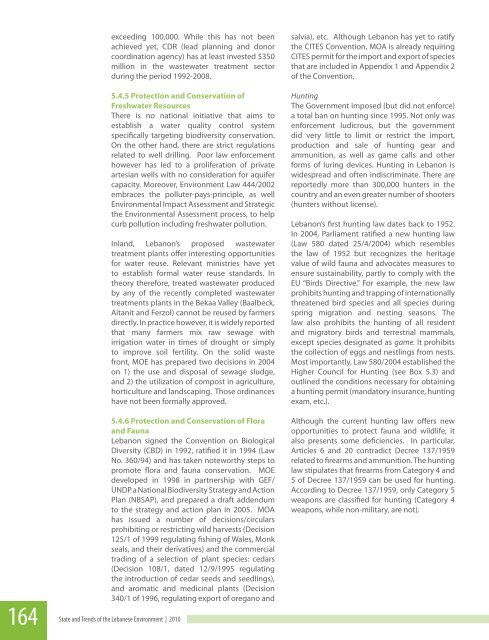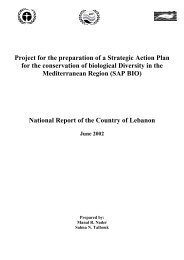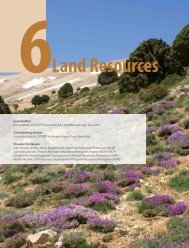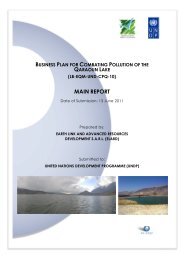Biodiversity and Forests
Biodiversity and Forests
Biodiversity and Forests
Create successful ePaper yourself
Turn your PDF publications into a flip-book with our unique Google optimized e-Paper software.
164<br />
exceeding 100,000. While this has not been<br />
achieved yet, CDR (lead planning <strong>and</strong> donor<br />
coordination agency) has at least invested $350<br />
million in the wastewater treatment sector<br />
during the period 1992-2008.<br />
5.4.5 Protection <strong>and</strong> Conservation of<br />
Freshwater Resources<br />
There is no national initiative that aims to<br />
establish a water quality control system<br />
specifically targeting biodiversity conservation.<br />
On the other h<strong>and</strong>, there are strict regulations<br />
related to well drilling. Poor law enforcement<br />
however has led to a proliferation of private<br />
artesian wells with no consideration for aquifer<br />
capacity. Moreover, Environment Law 444/2002<br />
embraces the polluter-pays-principle, as well<br />
Environmental Impact Assessment <strong>and</strong> Strategic<br />
the Environmental Assessment process, to help<br />
curb pollution including freshwater pollution.<br />
Inl<strong>and</strong>, Lebanon’s proposed wastewater<br />
treatment plants offer interesting opportunities<br />
for water reuse. Relevant ministries have yet<br />
to establish formal water reuse st<strong>and</strong>ards. In<br />
theory therefore, treated wastewater produced<br />
by any of the recently completed wastewater<br />
treatments plants in the Bekaa Valley (Baalbeck,<br />
Aitanit <strong>and</strong> Ferzol) cannot be reused by farmers<br />
directly. In practice however, it is widely reported<br />
that many farmers mix raw sewage with<br />
irrigation water in times of drought or simply<br />
to improve soil fertility. On the solid waste<br />
front, MOE has prepared two decisions in 2004<br />
on 1) the use <strong>and</strong> disposal of sewage sludge,<br />
<strong>and</strong> 2) the utilization of compost in agriculture,<br />
horticulture <strong>and</strong> l<strong>and</strong>scaping. Those ordinances<br />
have not been formally approved.<br />
5.4.6 Protection <strong>and</strong> Conservation of Flora<br />
<strong>and</strong> Fauna<br />
Lebanon signed the Convention on Biological<br />
Diversity (CBD) in 1992, ratified it in 1994 (Law<br />
No. 360/94) <strong>and</strong> has taken noteworthy steps to<br />
promote flora <strong>and</strong> fauna conservation. MOE<br />
developed in 1998 in partnership with GEF/<br />
UNDP a National <strong>Biodiversity</strong> Strategy <strong>and</strong> Action<br />
Plan (NBSAP), <strong>and</strong> prepared a draft addendum<br />
to the strategy <strong>and</strong> action plan in 2005. MOA<br />
has issued a number of decisions/circulars<br />
prohibiting or restricting wild harvests (Decision<br />
125/1 of 1999 regulating fishing of Wales, Monk<br />
seals, <strong>and</strong> their derivatives) <strong>and</strong> the commercial<br />
trading of a selection of plant species: cedars<br />
(Decision 108/1, dated 12/9/1995 regulating<br />
the introduction of cedar seeds <strong>and</strong> seedlings),<br />
<strong>and</strong> aromatic <strong>and</strong> medicinal plants (Decision<br />
340/1 of 1996, regulating export of oregano <strong>and</strong><br />
State <strong>and</strong> Trends of the Lebanese Environment | 2010<br />
salvia), etc. Although Lebanon has yet to ratify<br />
the CITES Convention, MOA is already requiring<br />
CITES permit for the import <strong>and</strong> export of species<br />
that are included in Appendix 1 <strong>and</strong> Appendix 2<br />
of the Convention.<br />
Hunting<br />
The Government imposed (but did not enforce)<br />
a total ban on hunting since 1995. Not only was<br />
enforcement ludicrous, but the government<br />
did very little to limit or restrict the import,<br />
production <strong>and</strong> sale of hunting gear <strong>and</strong><br />
ammunition, as well as game calls <strong>and</strong> other<br />
forms of luring devices. Hunting in Lebanon is<br />
widespread <strong>and</strong> often indiscriminate. There are<br />
reportedly more than 300,000 hunters in the<br />
country <strong>and</strong> an even greater number of shooters<br />
(hunters without license).<br />
Lebanon’s first hunting law dates back to 1952.<br />
In 2004, Parliament ratified a new hunting law<br />
(Law 580 dated 25/4/2004) which resembles<br />
the law of 1952 but recognizes the heritage<br />
value of wild fauna <strong>and</strong> advocates measures to<br />
ensure sustainability, partly to comply with the<br />
EU “Birds Directive.” For example, the new law<br />
prohibits hunting <strong>and</strong> trapping of internationally<br />
threatened bird species <strong>and</strong> all species during<br />
spring migration <strong>and</strong> nesting seasons. The<br />
law also prohibits the hunting of all resident<br />
<strong>and</strong> migratory birds <strong>and</strong> terrestrial mammals,<br />
except species designated as game. It prohibits<br />
the collection of eggs <strong>and</strong> nestlings from nests.<br />
Most importantly, Law 580/2004 established the<br />
Higher Council for Hunting (see Box 5.3) <strong>and</strong><br />
outlined the conditions necessary for obtaining<br />
a hunting permit (m<strong>and</strong>atory insurance, hunting<br />
exam, etc.).<br />
Although the current hunting law offers new<br />
opportunities to protect fauna <strong>and</strong> wildlife, it<br />
also presents some deficiencies. In particular,<br />
Articles 6 <strong>and</strong> 20 contradict Decree 137/1959<br />
related to firearms <strong>and</strong> ammunition. The hunting<br />
law stipulates that firearms from Category 4 <strong>and</strong><br />
5 of Decree 137/1959 can be used for hunting.<br />
According to Decree 137/1959, only Category 5<br />
weapons are classified for hunting (Category 4<br />
weapons, while non-military, are not).





